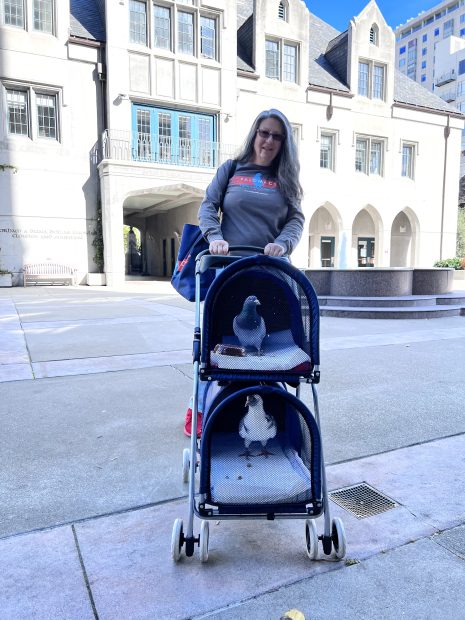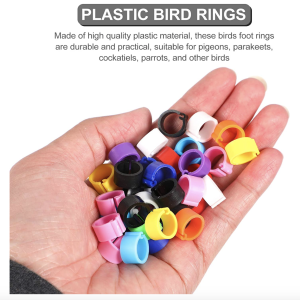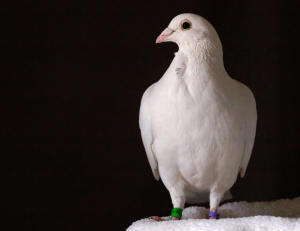Why can’t rescues rehome all the pigeons? We rescuers wish we could! We wish the size of the problem was manageable but it is not. The number of fanciers & hobbyists who breed, use & lose domestic pigeons far exceeds the rescue resources helping them. Most of these beautiful birds, when they get lost & hurt, die alone, unseen. Even together, we are helping only the tip of the iceberg, only the luckiest few who are rescued alive.
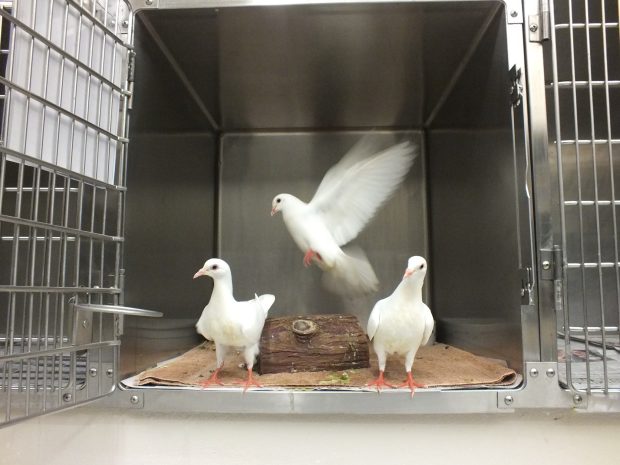
Domestic King pigeon fledglings at SFACC. Bred for meat (squab), sold live, “released” into an unsurvivable wild & lucky enough to be rescued alive.
Ten Tips for Shelters Rescuing & Rehoming Pigeons
This article focuses on domestic, unreleasable pigeons that need to be placed with adopters. (Releasable feral pigeons need pigeon-friendly rehab.)
- Embrace that pigeons are adoptable and make amazing companions.
- Learn why pigeons make such ideal companions indoors with family or outside in predator and rodent-proof aviaries.
- Connect with a pigeon rescue expert for ongoing assistance. Palomacy will help you!
- Discover your pigeon people by identifing the pigeon lovers (old & new!) within your staff, volunteers and community.
- Learn rescue-based pigeon basics (rather than fanciers’): care requirements, how to identify ferals and domestics, inhumane practices, etc.
- Set up your pigeon habitats including a cage in the lobby!
- Promote and publicize pigeons for adoption (names, photos, bios, outreach events, etc.)!
- Screen potential adopters to ensure safe, proper housing, avian vet care, no breeding (provide fake eggs!), no free-flying.
- Connect adopters to a supportive pigeon rescue community such as the Palomacy Help Group.
- Celebrate your wonderful selves for delivering compassion to all!
FAQs: Yes, pigeon pants are a thing! No, don’t try to trace sport bands; they’re designed to record winners, not recover the lost. No, pigeons won’t make you sick. Yes, pigeons are very smart!
1 & 2 Pigeons ARE Adoptable & Make Amazing Companions
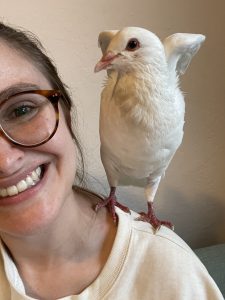 When I first started helping shelter staff to rehome domestic pigeons, they did not believe they were adoptable. Thankfully that perception is changing. Now more and more people are aware of their plight and their potential. And Palomacy has 16 years of expertise with thousands of happy adopters and adoptees as proof.
When I first started helping shelter staff to rehome domestic pigeons, they did not believe they were adoptable. Thankfully that perception is changing. Now more and more people are aware of their plight and their potential. And Palomacy has 16 years of expertise with thousands of happy adopters and adoptees as proof.
Misperceptions vs. Reality
People mistakenly think pigeons need a lot of exercise, want to fly all over and be free. They don’t. Domestic pigeons cannot be safely free-flown (no domestic sky) and fortunately they don’t much miss it. Pigeons are ground foragers whose feet are more important than their wings for day to day quality of life. And they are low energy, couch potatoes who LOVE the easy life. They are masters of the leisure arts and love to lounge in the sunshine, soak in their bath, flirt with prospects (including shoes, vacuum cleaners, their reflections), nap on pillows, snuggle and watch movies, nest build and fegg (fake egg) sit, and just savor the good life. They are vegan granivores who love foraging for their seeds. And pigeons are safe and harmless. They are a much lower disease/injury risk than dogs or cats or rabbits. Pigeons are soft bills without the beak strength to bite hard nor do they chew up cords, furnishings, etc. Pigeons are very smart (though not in a show-off kind of way), have deeply felt emotions, are quiet, good natured and charming. If you don’t think pigeons are great companion animals, I respectfully suggest that you don’t know pigeons. Read adopters’ stories in our blog and their reviews to learn more.
3 Connect with a Pigeon RESCUE Expert
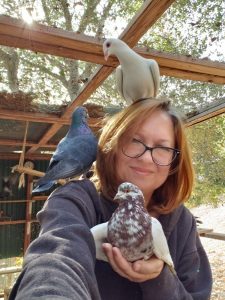 Pigeons have been bred and used by humans for thousands of years. They have a long history of being exploited and the vast majority of traditional care info available online and in books centers their usefulness over their well being so it is important to seek out a pigeon RESCUE expert. Pigeon racers, breeders, sellers, fanciers, etc. engage in a whole range of inhumane practices that are dangerous for the birds. (Learn more Pigeons’ Leg Bands: What Do They Mean?, Why “Dove Releases” Are Cruel, Violet’s Story: What’s Wrong With Rollers?) Pigeon rescue experts know that domestic pigeons should not be free-flown; should not be allowed to hatch chicks (way, way too many “surplus” pigeons to ethically breed!); should not be kept standing on wire; should not be crowded… Rescuers will provide predator and rodent-proof aviaries completely wrapped with hardware cloth (never chicken wire!) and house no more than 30 pigeons in a 16′ x 8′ x 8′ enclosure while hobbyists and breeders house more than 100 in that same space. (Palomacy advises 32 or more cubic feet per bird for aviary pigeons. Breeders recommend 8 to 10 cubic feet.) Make sure you have a pigeon-centric RESCUE expert to help navigate all the info out there. And connect with an avian vet. Pigeons are SUPER resilient and most issues are treatable (many with just cage rest, supportive feeding and antibiotics). Pigeons can thrive blind, one-winged, one-legged… they are brilliant adapters and always make the best of their circumstances. (Need proof? We have LOTS of documentation. See Prince’s Story: Baby, I’m a Star! for one example. #WeDontHaveToStartWithEuthanasia) And rescuers are happy to support your pigeon work! Join our Palomacy Help Group, call 415 851-5948, and/or contact Elizabeth@pigeonrescue.org or Jill@pigeonrescue.org with questions and for referrals.
Pigeons have been bred and used by humans for thousands of years. They have a long history of being exploited and the vast majority of traditional care info available online and in books centers their usefulness over their well being so it is important to seek out a pigeon RESCUE expert. Pigeon racers, breeders, sellers, fanciers, etc. engage in a whole range of inhumane practices that are dangerous for the birds. (Learn more Pigeons’ Leg Bands: What Do They Mean?, Why “Dove Releases” Are Cruel, Violet’s Story: What’s Wrong With Rollers?) Pigeon rescue experts know that domestic pigeons should not be free-flown; should not be allowed to hatch chicks (way, way too many “surplus” pigeons to ethically breed!); should not be kept standing on wire; should not be crowded… Rescuers will provide predator and rodent-proof aviaries completely wrapped with hardware cloth (never chicken wire!) and house no more than 30 pigeons in a 16′ x 8′ x 8′ enclosure while hobbyists and breeders house more than 100 in that same space. (Palomacy advises 32 or more cubic feet per bird for aviary pigeons. Breeders recommend 8 to 10 cubic feet.) Make sure you have a pigeon-centric RESCUE expert to help navigate all the info out there. And connect with an avian vet. Pigeons are SUPER resilient and most issues are treatable (many with just cage rest, supportive feeding and antibiotics). Pigeons can thrive blind, one-winged, one-legged… they are brilliant adapters and always make the best of their circumstances. (Need proof? We have LOTS of documentation. See Prince’s Story: Baby, I’m a Star! for one example. #WeDontHaveToStartWithEuthanasia) And rescuers are happy to support your pigeon work! Join our Palomacy Help Group, call 415 851-5948, and/or contact Elizabeth@pigeonrescue.org or Jill@pigeonrescue.org with questions and for referrals.
4 Discover Your Pigeon People
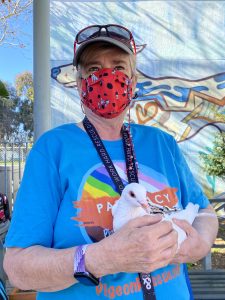
While pigeons are often maligned and have been treated as livestock rather than pets, once you start asking around, you will be surprised to find out how many people actually really like pigeons (or fall in love when they meet them). If you want to place pigeons with adopters, you need to get pigeon-appreciating people involved.
As Pam of Oakland Animal Services told me, “Not every pigeon person starts out loving them. I was asked to help clean the aviary and hesitantly agreed. Little did I know how much I would fall in love with them and find their cooing so soothing. I started cleaning the aviary with my AirPods in listening to music. I stopped that very early on when I found how pleasant and soothing their coos were.”
So true! Most of our volunteers and adopters come to us with no prior interest whatsoever in pigeons! They are just stopping by our booth at an adoption fair or reaching out for help with an injured pigeon camped out on their porch & are blown away to discover how loveable they are! Involve every one in your pigeon project initially, even the skeptics, and you’ll discover some pigeon lovers who didn’t even know they were.
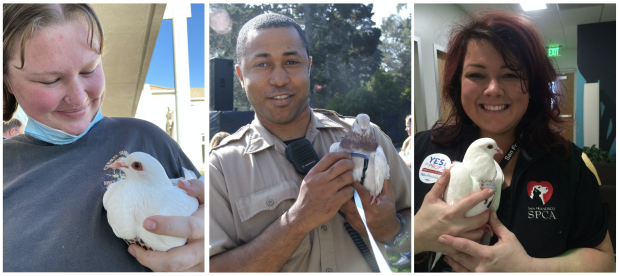
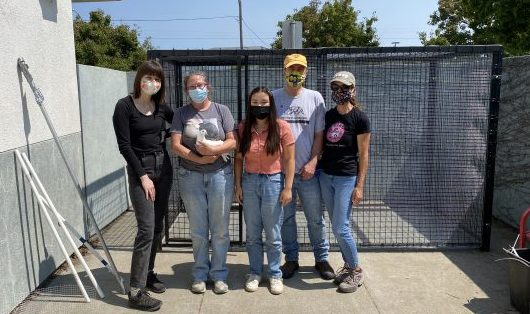
5 & 6 Pigeon Care Basics & Setting Up Habitats: How to Welcome Pigeons Into Your Life
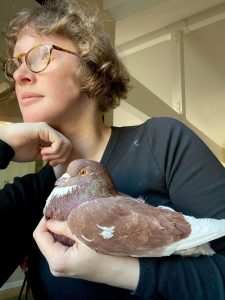
Courtney & Ray
Pigeons do great indoors as family pets. They can also live outside in a predator & rodent-proof aviary but I would never make a single pigeon live outside alone. They are flock birds and to be outside alone is stressful and lonesome for a pigeon. A single pigeon living indoors adopts the people as flock members. (If a pigeon is going to be outside even temporarily, she must be in a predator-proof cage. Most birds cages are designed only to keep birds confined indoors and they are not predator-proof outside. To be predator-proof, the cage must be sturdily built, have very narrow spacing between bars and a raccoon-proof latch.) Please see How to Choose a Cage for Pigeons or Doves for detailed and important considerations regarding putting a bird in a cage and see How to Create an Aviary for Pigeons or Doves for the same regarding housing birds outside. Also check out How to DIY make a Safe, Easy Pigeon or Dove Aviary.
If we had our way, there would be no pet pigeons. They would all be wild and free, not captive. Palomacy doesn’t believe that birds should be domesticated, bred and used by people for any reason. But, because people do breed, use and lose domestic unreleasable pigeons, there are a great many in need of rescue and homes. This is for those birds and the compassionate people who save their lives through rescue and adoption. There’s lots, lots more to learn about pigeons and what amazing companions they can be. Keep reading and join us in our Help Group on Facebook. Thank you for being a friend to pigeons. They are angels among us.
RESCUED OR ADOPTED INDOOR PIGEONS NEED
- an appropriate cage for their home base 36″ or more wide
- a big mirror (pigeons self-recognize & enjoy mirrors )
- fresh food and water daily (flat bottom ceramic dishes are best)
- safe, daily out-of-cage time in the house for exercise & fun
- a big flat-bottom casserole type dish for bathing
- safe access to sunshine unfiltered by glass & avian-safe full spectrum lighting
- inclusion in the family & company (yours or another pigeon)
Check out How to Care for a Rescued Pigeon & How to Choose a Good Cage for Pigeons or Doves
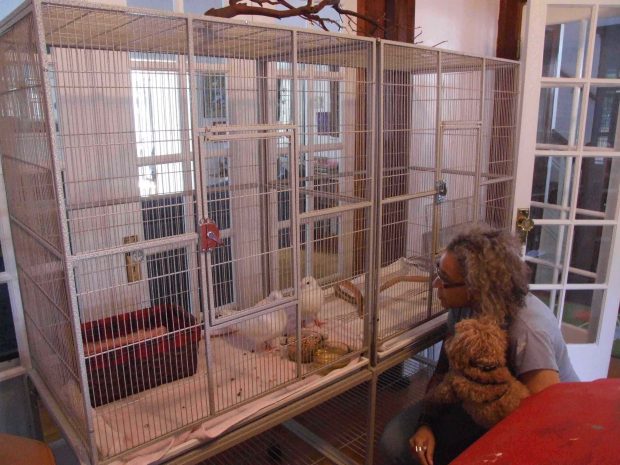
Janelle & Beep chat up Petey & Pineapple in their double-flight cage
RESCUED OR ADOPTED OUTDOOR PIGEONS NEED
- a predator & rodent-proof aviary (they cannot live outside loose or in a cage) with a maximum hardware/mesh opening of .5″
- a minimum aviary size of 4’ W x 6’ L x 6’ H (bigger is better, they can’t be let out safely)
- other pigeons (single pigeons cannot be alone in an outdoor aviary)
- a big mirror (pigeons self-recognize & enjoy mirrors )
- nest boxes (one per couple) & nesting materials (e.g., pine needles)
- fresh food and water daily (flat bottom ceramic dishes are best)
- large flat-bottomed pan or dish for bathing
Check out How to Create an Aviary
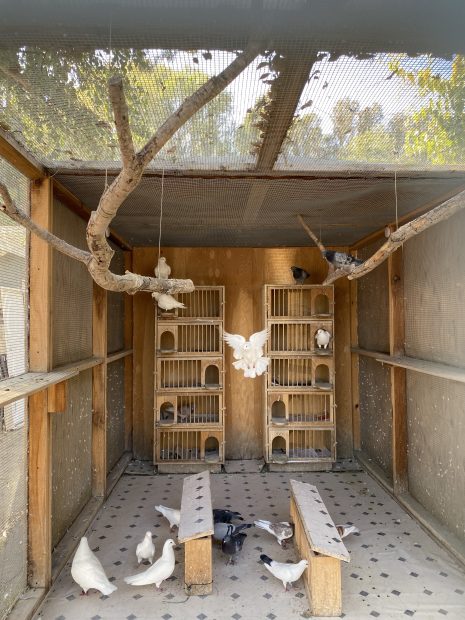
& How to Make the Easiest, Safest DIY Aviary
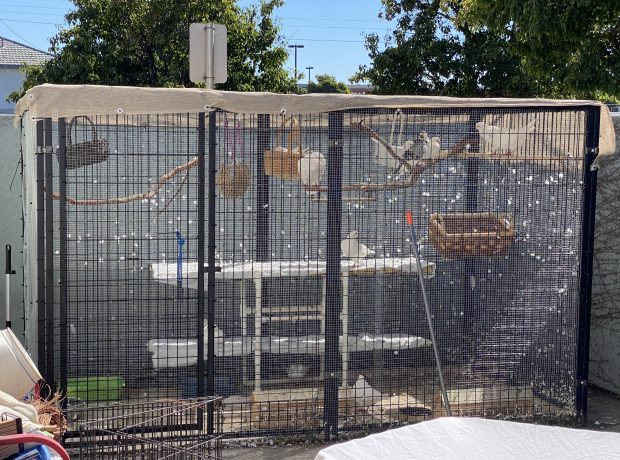
OAS kennel aviary
Continue How to Welcome Pigeons Into Your Life
#1 Pro Tip: House Pigeons in Your Lobby!
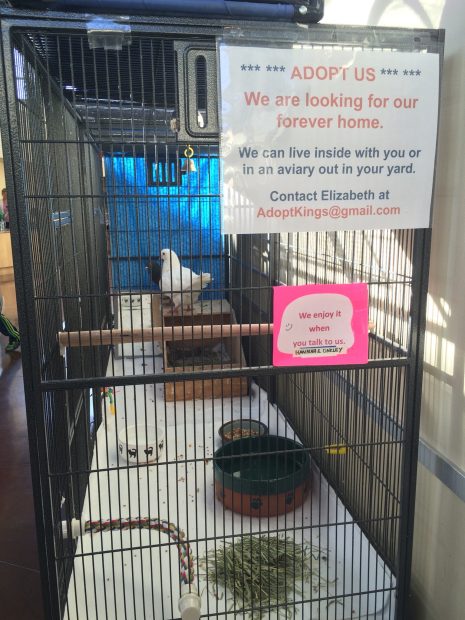
The single best thing a shelter can do to get pigeons adopted is to house one or a pair in a cage in your lobby. We’ve heard all kinds of objections over the years- But the dogs will go crazy. It will be too hhectic for them. We don’t have room. They’ll have to see scary predators. And yet none of those are good reasons to exclude pigeons from the lobby. Here are the facts.
- The birds will see and be seen by people! The pigeons need the promotion, appreciate the entertainment & will exhibit more of their natural behaviors in a lobby cage than they will in a back room kennel. Pigeons LOVE to be where the action is & the proximity will strengthen their bi-culturalness and adoptability.
- The people will learn about domestic pigeons, become familiar with their need for rescue and adoption, their potential as companions, and enjoy their charming ways (flirting, snuggling, kissing, bathing, strutting, etc.)
- The shelter will benefit from the exposure, word of mouth, the pigeons’ more natural behaviors, and the increased awareness that generates support and adoptions.
Check out: Great Big News Lobby Pigeons!
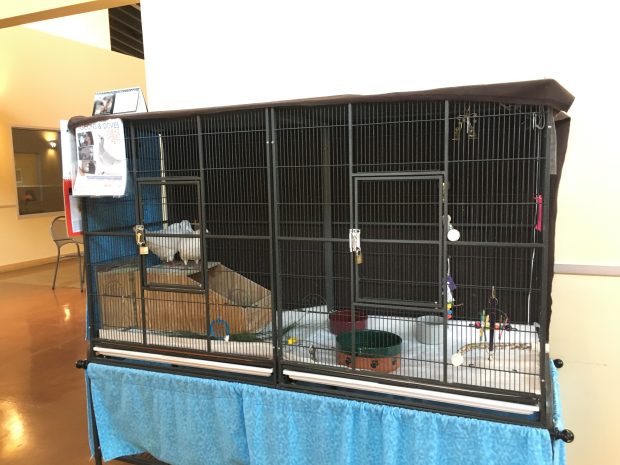
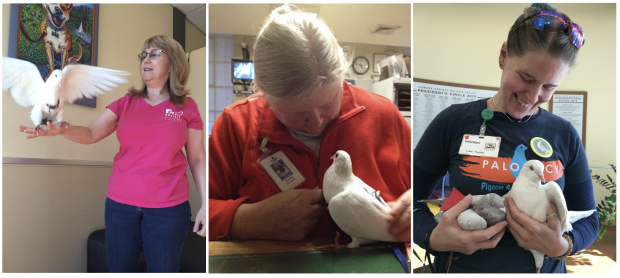
7 Promote and Publicize
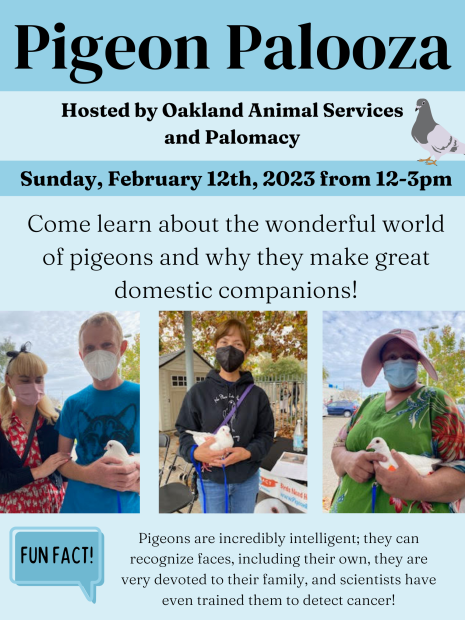
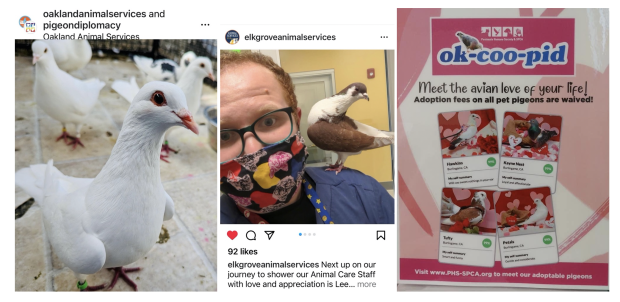
Pigeons are super easy to photograph (they’re calm and regal and gorgeous) and with photos, names and bios, YOU CAN GET THEM ADOPTED! Sometimes shelters post a photo of a bunch of pigeons and don’t differentiate the individuals, the married couples, the old ones, the sassy… a pigeon expert friend can help you to make those distinctions and teach your team too. (It’s easy!) You can get plastic color snap on bands or use colored zip ties as anklets to keep track of which pigeon is which. And they are all individuals! Sit down (less threatening) and watch them for awhile to get to know who is who.
8 & 9 Screen Potential Adopters & Connect Them to Support
Successfully placing pigeons as companion animals requires adopters informed with & committed to up to date best practices for their care. No free-flying; no breeding; predator & rodent-proof aviary for outdoor living or a big cage with safe out time in the house; company (either a compatible pigeon or human BFF)… Palomacy is always happy to help assess before the adoption and to provide the ongoing coaching.
Recommended Reading
How to Welcome Pigeons Into Your Life
How To Hold a Pigeon
How to Choose a Cage
How to Create an Aviary
Why It’s Too Dangerous for Pet Pigeons to Free Fly
But I Have a Cat &/or Dog…?
pHarmony: Match Making for Pigeons
How to Replace Real Eggs with Fakes for Hatch Prevention
What Are Pigeon Pants & Where Do I Get Some?
Palomacy Expectations for Dove & Pigeon Adopters
Daily care. Fresh food, clean water, poop clean-up, checking for and replacing eggs
Companionship. Lots of time with you or another bird, not home alone all day. Supervised, safe, indoor out-of-cage time daily, unless living in an aviary.
Veterinary care. Exams and treatment from an avian veterinarian if sick or injured
No free flight. No uncaged time outdoors unless properly protected in a stroller, carrier, or harness
No breeding. Hatch prevention if your bird has a mate. Replace real eggs with fake.
No exploitation. No selling, sporting or business use of Palomacy birds
Forever home. Provide a safe and loving home under all circumstances (including illness or moving) and a pet-care plan in case something happens to you. If you feel you are unable to keep your bird, contact Palomacy first, with an offer to return the bird to us.
10 Celebrate!
You are helping to close a deadly gap in the animal welfare community. You are extending the reach of compassion. You are AMAZING!
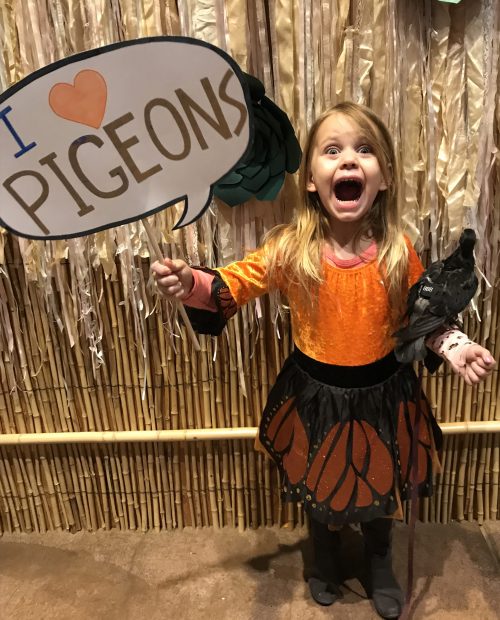
BONUS: What’s the Difference Between Pigeons & Doves?
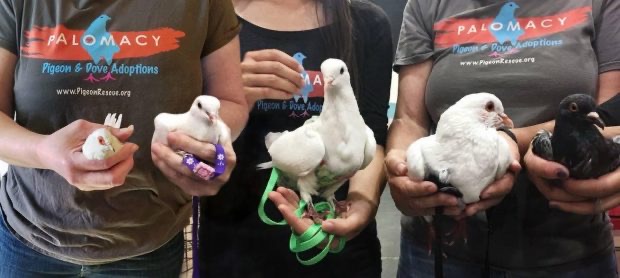
Pigeon and Dove – the terms are sometimes used interchangeably, and often incorrectly. Both comprise the order Columbiformes, with over 300 species. Rather than delve into the technical and scientific names, let’s focus on the domestic species that Palomacy primarily serves, why it’s important to distinguish them, and how they differ as pets. Depending on your location, you may see other members of the Columbidae family in your backyard – we’ll save these species for another post. Continue
BONUS BONUS: What’s the Difference Between Feral and Domestic Pigeons?
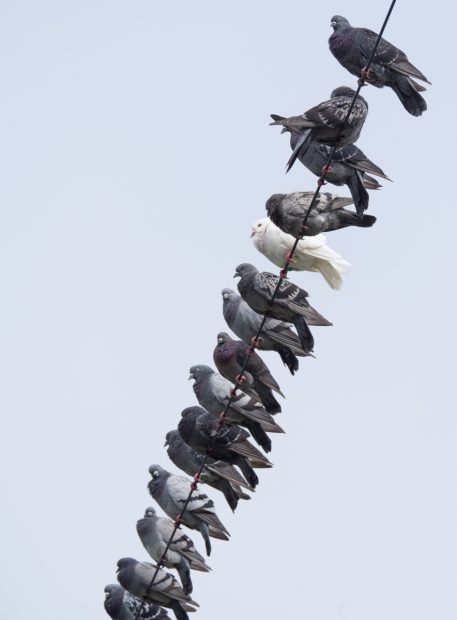
Feral flock with domestic visitor by Ingrid Taylar
Feral Pigeons: Self-reliant, Survival of the Fittest
Our world is full of pigeons! Most of us are familiar with the feral pigeons living wild and free in our cities and towns. Did you know they are super smart? That they flirt a lot but mate for life? That they can fly 60 miles per hour? They are completely harmless and much less a risk to our health than our own dogs and cats. They are beautiful neighbors and when they need help, the first option should be to rehab them and release back to their flock and life. If a feral pigeon proves unreleasable, they adjust very quickly to life in our homes or aviaries as companions. Blind, missing a wing or a foot, neurological- they all adjust and if provided with a good home, they love the soft life a lot more than they miss being free. (Pigeons are masters of the leisure arts!) If you’re not sure how to determine a pigeon’s releasability, get help from an expert!
Domestic Pigeons: Man-made, Dependent & Defenseless
Domestic pigeons are birds that humans have selectively inbred (for many hundreds of generations) for traits they want who are confined for use and ruined for wild living. There are more than 300 breeds of domestic pigeons- from the big, white king pigeons bred for meat (squab) to little white homer pigeons bred to used for “dove release”; fast, muscular pigeons bred to be cruely used for “racing”; small rollers and tumblers selectively inbred for seizure disorders that trigger somersaults in mid-flight; fancy exotics like fantails and trumpeters, pouters, owls, frillbacks, jacobins, capuchins, etc.etc. They can look all kinds of ways, come in all colors and rarely act tame (unless sick, weak or human-bonded). Due to their breeding, weird traits, lack of wild parenting and flock, they can’t survive like the ferals do.
Questions? Ideas? Suggested edits? Please email Elizabeth@pigeonrescue.org Thank you!
